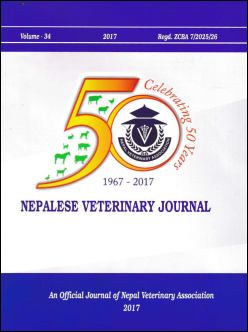Study of Antibiotic Resistance on Escherichia Coli in Commercial Poultry of Nepal
DOI:
https://doi.org/10.3126/nvj.v34i0.22859Keywords:
Antibiotic resistance, E. coli, poultryAbstract
The continuous use of antibiotics in compound feed at sub-therapeutic level has been an integral part of commercial poultry production in Nepal, which is one of the factors that promotes bacterial resistance. Hence, with the objective to determine antibiotic resistance in commercial poultry of Nepal, this study was designed taking Escherichia coli as a flagship bacterium. The commercial layers and broilers birds brought to veterinary teaching hospital of Agriculture and Forestry University by commercial poultry producers for disease diagnosis and treatment were considered as clinical examination of birds were carried out followed by post mortem examination (PME). Those layer/broiler birds which were not taking antibiotic orally or parenterally for last 2 weeks and diagnosed with collibacillosis on PME were included in sampling frame. Air sacculitis, fibrinous pericarditis, fibrinous perihepatitis, and coligranuloma were major criteria for presumptive diagnosis of colibacillosis on PME. The first 40 for both broiler and layer birds totaling 80 that fulfilled the criteria were selected as samples, each representing a commercial farm. All necessary information on daily management practices and previous treatments were obtained from farmer’s record book or sheets or face to face interview. Avian pathogenic E. coli was isolated from aseptically collected liver samples and confirmed by biochemical tests. Antibiogram of the isolates were investigated by means of Kirby-Bauer disc diffusion method. E. coli was isolated from all liver samples taken for the culture. It was found that E. coli were resistant most substantially towards Cephalexin (81.2%) and Amoxycillin (81.2%) followed by Tetracycline (78.8%), Colistin sulphate (n=50, 62.5%). Chloramphenicol (61.2%), Ciprofloxacin (55.0%), Enrofloxacin (53.8%), Levofloxacin (28.8%), however, no resistance was found against amikacin. The proportion of E. coli isolates that were resistance against Colistin sulphate (p<0.05), Chloramphenicol (p< 0.05), Tetracycline (p<0.001), Ciprofloxacin (p<0.01), Enrofloxacin (p<0.05) and Gentamicin (p<0.01) were significantly higher in layers compared to that of broilers. In conclusion, avian pathogenic E. coli were resistant towards several antibiotic molecules commonly used in commercial poultry of Nepal, and the resistance was higher in layers compared to broilers.
Downloads
Downloads
Published
How to Cite
Issue
Section
License
© Nepal Veterinary Association




